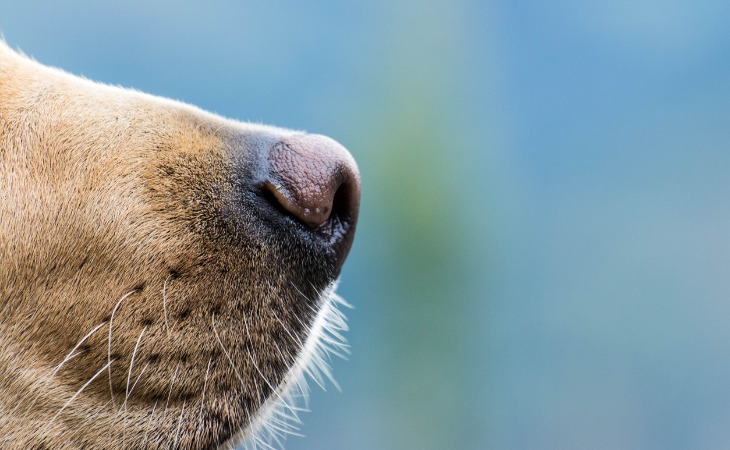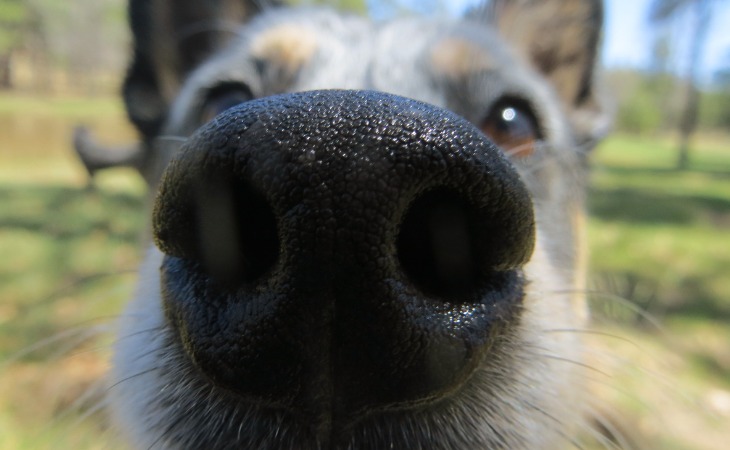Whether your dog has a long muzzle or a short one, every dog has a cute and boopable nose. Generally dark in color, ranging from brown to black to gray, the nose is part of their respiratory system and powerful olfactory system. It consists of two nostrils with an alar fold that divides air that is breathed in. One part is for breathing, while the other is for odor detection.
The outer wall of the nose is made up of a very thick epidermis, which is sometimes wet and sometimes dry. But why does this happen? Should you worry when your dog has a dry nose? Read on to find out!
How does my dog’s nose work?
Noses allow dogs to breathe and distinguish smells.
A respiratory organ
The nose and muzzle are visible parts of the dog’s respiratory system. Other parts of their respiratory system are their mouth, pharynx, larynx, trachea, lungs, and diaphragm. By breathing in and out through their nostrils, they move air in and out of their body, just like us.
Your dog’s respiratory system works in the same way as yours. Similar to us, they also breathe through their mouths when they have make significant physical efforts or when they are hot. When they do this, they are temporarily not using the olfactory function of their nostrils. Dogs that are alert always have their jaws closed in order to better smell odors and concentrate on their objective.
An olfactory organ
A dog’s sense of smell is 40 times more developed than that of a human being. Their sense of smell is, along with their hearing, is their most efficient way of finding their way around. Smelling allows dogs to know where they are and become familiar with their immediate environment. In addition, smells help dogs find food and appreciate their food. Their sense of smell allows them to recognize females in heat because they emit a specific scent. Lastly, pheromones in the air are used by dogs to evaluate their interactions with other animals, judging whether they are friendly or hostile. This is why dogs sniff each other when they meet.
Why is my dog’s nose wet?
Unlike us, dogs usually have moist noses. But why is this? How does it affect them?
Naturally moist
A dog’s nose is naturally slightly moist. The tip of their nose is covered with a sort of mucus that protects its epidermis. This substance help them to better capture and analyze odors. Therefore, it is normal for a dog to have a wet nose. It shows that their respiratory and olfactory system is working well. Dogs lick their nose to moisten it when faced with an appetizing food. This allows them to enjoy their meal to the fullest.
A deceptive sign of good health
Even if a wet and fresh nose typically indicates that a dog does not have a respiratory or olfactory disease, this does not always mean that they are in good health. Just like humans, their noses reacts strongly to their environment, being able to go quickly from dry to wet or from hot to cold. When the temperature is low, their body produces more mucus than usual to protect their airways. For this reason, their nose is wetter when it is cold. Therefore, in this way, their nose is wet because the air is cold and not because they are healthy.

Wet noses and diseases
A wet nose that is large and/or has colored discharge on it should alert you. This may be a symptom of an illness or infection such as coryza or pulmonary edema. When something is stuck in a dog’s airway, this can also cause discharge, as the body is unable to evacuate the intruder. In addition, discharge can also be a sign of a polyp or a dental problem. Therefore, you can depend solely on whether your dog’ nose is wet or dry to determine if your dog is in good health.
Why is my dog’s nose dry?
From time to time, a dog’s nose can become strangely dry. Is this normal? Why does this happen?
A temporary phenomenon
Just as cold temperatures can cause a dog’s nose to become moist, heat has an impact a dog’s nose as well. For example, when your dog takes a nap near a heater, this can often results in your dog having a temporarily dry nose. While a dry nose is abnormal if it lasts over time, there is no need to worry if your dog’s nose remains dry for a few hours.
With that being said, a female dog that has just had puppies typically has a dry nose because of the effort she puts into nursing them.
A symptom of a benign disorder
If a dog’s nose has been dry for several days, this may be a symptom of a benign condition.
Fatigue can cause prolonged dryness of the nostrils. To make the nose humid again, rest is usually enough. In addition, a dry nose can also be linked to dehydration. Giving your pet enough to drink will solve the problem. To make sure that it is temporary and benign, it is sometimes enough to observe the paw pads of your dog. If they are very dry and dehydrated, your dog’s dry nose is probabl caused by dehydration.
To help keep their nose moist, dogs naturally have a reflex to lick it. This allows them to recover all of their olfactory capacities, but the result is short-lived. You can help your dog by applying petroleum jelly to the tip of their nose. This will relieve them, rehydrate the nose and limit the appearance of cracks and small wounds.
A symptom of a disease
A dry nose is often a symptom of a deficiency (zinc, in particular). This deficiency progressively lowers the level of the dog’s immune defenses, which can lead to a dry nose. It is then important to regulate their diet by giving them food supplements or by radically changing their diet. If other symptoms appear, it is probably a sign that your dog is suffering from a disease.
If you notice that your pet has diarrhea, vomiting, or a fever in addition to a dry nose, it is very important to take your dog to the veterinarian. This is because your dog may be suffering from canine distemper or canine parvovirus, among others.
As we have mentioned earlier, the condition of a dog’s nose is not a reliable criterion to be 100% sure of their health and well-being. As the nose is a particularly sensitive, it can easily be hot or cold, wet or dry, depending on the weather and your dog’s lifestyle. However, while a wet nose is not a reliable sign of a dog’s health, it is good to know that a dog should normally have a moist nose.
In general, if your dog’s nose is wet but warm, it may indicate a fever. If the nose is dry but cool, it can indicate dehydration.
If symptoms persist after a few days even after you apply petroleum jelly and help your dog when it comes to rest and good hydration, you should take your dog to the veterinarian. They can then diagnose and prescribe treatment. You should also visit the veterinarian of your dog’s nose discharges a lot or when the texture or color of their nose changes.

